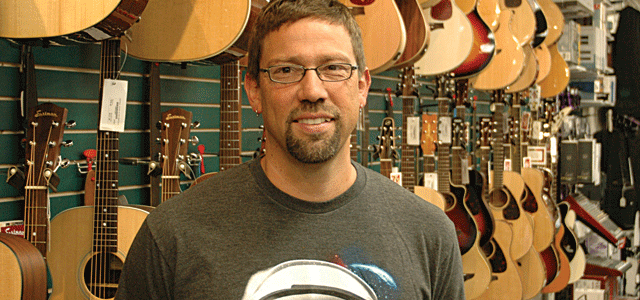Watermelon Music has gone through many iterations over the years, as Jeff Simons, its President, refined the brand to meet not only the needs of the community, but also his own high standards for what a music store ought to be. First as Davis Music in 1996, then as Second Street Music a few months later and, finally, as Watermelon Music in 2001, Simons’ store has proven that a Watermelon by any other name is just as sweet.
So, how did Simons come to own his own musical instrument store? A musician all his life, Simons’ experience in the music industry dates back to his middle school summer vacations, when he would get up early and drive to nearly all the music stores in the California central valley with his father, a road rep for Coast Wholesale Music. “Experiencing all these different stores gave me perspective on what made some stores cold and impersonal, whereas others were exciting and inspiring,” recalled Simons, who began getting seasonal work at local music stores while he was in high school and who, by college, was working part time at Davis Music, eventually working his way up to General Manager.
“The previous Owner opened the store in the mid-1970s, and was burnt out on the day-to-day operations of the business. But, from my communication with musicians and music instructors in the area, I was convinced that the community could and would support a quality music store,” Simons related. He left to do a short tour of East Germany as a bass player for saxophonist John Tchicai. Upon his return, he continued, “I learned that the store had taken a turn for the worse during my absence. I put in my notice, unsure of what exactly I would do, but confident that there wasn’t much of a future at the existing store.”
Rather than hiring someone new, Simons’ boss offered to sell him the store. Along with business partner Andrew Enberg—the drummer in that East German rhythm section—Simons came up with a business plan and, a few weeks later, he was the Owner of Davis Music, a 3,500-square-foot store with five teaching studios and a small repair shop.
“We moved out most of the existing inventory with a storewide sale, and we redesigned the interior to look the way we thought an independent store should look,” said Simons. “After five months, when it felt like we were a different business, we had our grand opening as Second Street Music.”
From the start, Simons knew that, if he wanted to be successful, he had to get two types of customers on his side. The first were local musicians looking for a safe and friendly place to try out new gear. “We have always wanted to have a true ‘family-friendly’ store, where customers are treated with respect and courtesy, regardless of gender, age, musical ability or tattoo quantity,” Simons stressed. “One of Watermelon Music’s original advertising slogans was, ‘Our Staff is Refreshingly Rock-Star Free.’ Customers who had frequented some nearby music stores knew exactly what we meant.”
The other important group Simons needed to court was the local music teachers. As his former boss became more and more disillusioned with the business, the store had stopped stocking what the music programs needed, resulting in many music teachers no longer shopping locally. So, Simons went to work getting them back.
“We invited all the local teachers to a reception at the new store and asked everyone to help us make this a store where they’d be happy to shop. We solicited advice on merchandise that would make their teaching easier, and we did our best to follow through and carry many of the products and implement many of the policies that they had recommended,” Simons remarked. “Once they saw that we were serious about supporting them, we received a lot of business from them and their referrals. And we continue to solicit input from local teachers. It’s as useful today as it was when we opened.”
The store has grown a lot since then, moving to a new location in 2001 (where it was officially christened Watermelon Music). Simons doubled the footprint of his store, occupying more than 7,000 square feet, 10 teaching studios and a large repair shop. In 2003, the store grew again, taking over the entire 10,000-square-foot building, and incorporating 19 teaching studios and a full office suite with rooms for back stock, receiving, rental instrument storage and more.
The store currently operates with two Owners (Simons and Ron Cowden), a Guitar Department Manager, an Orchestra Department Manager, a Band Department Manager, a Drum Department Manager, a Receiving Clerk and a couple of part-time employees. They use independent contractors for fretted-instrument repairs, band-instrument repairs, amps and electronics repairs, and orchestra-instrument repairs, and the store has 30 to 40 music instructors renting studio space at any given time.
As with any store, Simons has seen fluctuations in sales and services among his different departments, and Watermelon Music still has not bounced back completely from the Great Recession, which crippled the global economy at the end of the last decade.
“We have had to learn to budget and monitor expenses much more carefully than we ever did before,” Simons admitted. “I am trying to run my business in a more ‘businesslike’ fashion, running a lot more reports and analyzing each department much more closely. This has sometimes entailed ending relationships with vendors we’ve been involved with since the beginning, as it becomes clear that their current requirements, profit potential and general philosophy run counter to my store’s best interests.”
But that doesn’t stop him from doing right by his community and his customers. Whether he’s offering free restringing services for customers who purchase strings in the store or whether he’s giving out an annual $5,000 grant to promote arts and music in the local public schools, Simons never loses focus on what matters most: supporting the schools, the public and the community.


